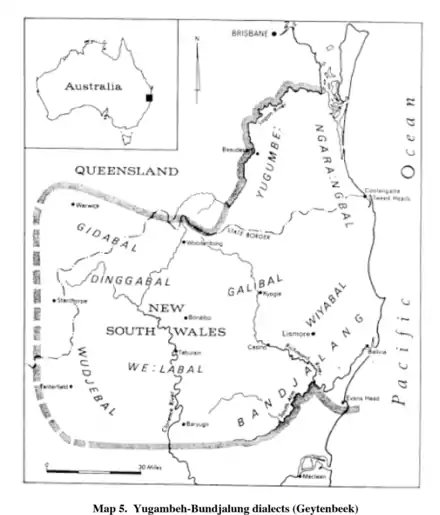Githabul language
Githabul, also known as Galibal, Dinggabal, and Condamine – Upper Clarence Bandjalang, is an Australian Aboriginal language spoken by the Githabul living in South Queensland and North-East New South Wales.
| Githabul | |
|---|---|
| Ethnicity | Githabul, Kalibal, Geynyan |
Native speakers | 4 (2016 census)[1] |
Pama-Nyungan
| |
| Dialects |
|
| Language codes | |
| ISO 639-3 | gih |
| Glottolog | cond1242 |
| AIATSIS[2] | E14 Githabul |
| ELP | Githabul |
Nomenclature

In the Githabul language, the word githabul means 'those who say githa'; githa means 'that's right' and is a common exonym and endonym for the people and their language.
Githabul specifically refers to the language as spoken around Woodenbong, while the southern variety spoken near Drake was known as Dingabal which means 'those who say dinga', with dinga meaning 'that's right'.
The eastern variety spoken near Kyogle on the Richmond river used the term galibal which meant 'those who say gali'; gali means 'this' and contrasts with Githabul and Dinggabal which used gale.[3]
Grammar
Verb morphology
Verbs are conjugated with the use of suffixes. It is an aspect-dominant language, as opposed to tense-dominant like English. Githabul suffixes mostly conjugate for aspect and mood.
Suffixes
Verb suffixes are placed in six orders. A verb may not take more than one suffix from an order, and similar to nouns, suffixes are attached in a set order. Combinations of these suffixes express all possible conjugations of Githabul verbs, with only a small number of combinations possible. Githabul verb stems are commonly two syllables in length and always end in a vowel.[4]
| 1 | 2 | 3 | 4 | 5 | 6 |
|---|---|---|---|---|---|
| -ba
'causative' |
-ndi
'Carry whilst...' |
-li 'reflexive/passive' | -ja
'Past tense' |
-hn 'imperfective aspect' | -du 'habitual mood' |
| -wa
'repetitive' |
-hny 'imminent aspect' | -i 'preconditional' | |||
| -ma
'causative' |
-h 'imperative' | -de 'preconditional' | |||
| -hla 'continuous aspect' | |||||
| -nah 'antechronous aspect' | |||||
| -nyun 'synchronous aspect' | |||||
| -yah 'purposive' | |||||
| -jin 'synchronous aspect' | |||||
| -n 'permissive' | |||||
| -ni 'perfective' |
Adjective Morphology
Adjectives can be marked with a suffix to indicate the gender of the noun they qualify. Githabul has one of the most extensive gender systems of all the Bandjalangic languages.[5]
Suffixes
| Gender | Suffix |
|---|---|
| Animate (male) | -gali |
| Animate (female) - weak quality | -gan |
| Animate (female) - strong quality | -galigan |
| Animate (female) - size | -Nahgan |
| Arboreal | -Nahn* |
| Neuter | -gay |
*N stands for a homorganic nasal.
Demonstratives
Githabul possesses a complicated set of demonstratives that make a three-way distinction, with proximal, medial, and distal sets. There is a further distinguishing of demonstrative adjectives and location demonstratives. The adjective set can be additionally suffixed to create demonstrative pronouns. The adjective set has three forms for "things in sight", "things hidden or not in sight" and "things not there anymore", while the location set has forms to indicate the general area and definite area, whether in sight or not in sight, and past and present forms.[6]
Adjective set
| Demonstratives | Proximal (this) | Medial (that) | Distal (that over there) |
|---|---|---|---|
| In sight (sg)* | gale | male | gile |
| In sight (plrl) | gahnyu | mahnyu | gahmu |
| Not in sight (sg) | gunah | munah | gahba |
| Not in sight (plrl) | ganyeh | manyeh | gahnye |
- The Galibal dialect uses the forms Gali, Mali and Gili.
The above set can be suffixed with order 7 noun suffixes to form demonstrative pronouns that function like ordinary independent nouns. e.g. Yanindeh galeni wangahbaya! 'Take this with you!
The 'not in sight' and 'not here anymore' forms can take the order 2 noun suffix -gan to form time words. E.g gunahgan 'recently'.
Location set
| Demonstratives | Proximal (here) | Medial (there) | Distal (over there) |
|---|---|---|---|
| In sight (definite area) | gaji | maji | gah |
| In sight (general area) | gunu | munu | gundeh |
| Not in sight (present) | gayu | mayu | guhyu |
| Not in sight (past) | gaye | maye | gahye |
References
- Githabul at Ethnologue (25th ed., 2022)

- E14 Githabul at the Australian Indigenous Languages Database, Australian Institute of Aboriginal and Torres Strait Islander Studies
- C., Sharpe, Margaret (2005). "Yugambeh-Bandjalang Dialects". Grammar and texts of the Yugambeh-Bundjalung dialect chain in Eastern Australia. Muenchen: Lincom Europa. pp. 17–32. ISBN 3895867845. OCLC 62185149.
{{cite book}}: CS1 maint: multiple names: authors list (link) - C., Sharpe, Margaret (2005). "The Verbs". Grammar and texts of the Yugambeh-Bundjalung dialect chain in Eastern Australia. Muenchen: Lincom Europa. pp. 57–74. ISBN 3895867845. OCLC 62185149.
{{cite book}}: CS1 maint: multiple names: authors list (link) - C., Sharpe, Margaret (2005). "Nouns, Adjevtives and their Sufffixes". Grammar and texts of the Yugambeh-Bundjalung dialect chain in Eastern Australia. Muenchen: Lincom Europa. pp. 77–96. ISBN 3895867845. OCLC 62185149.
{{cite book}}: CS1 maint: multiple names: authors list (link) - C., Sharpe, Margaret (2005). Grammar and texts of the Yugambeh-Bundjalung dialect chain in Eastern Australia. Lincom Europa. ISBN 3895867845. OCLC 62185149.
{{cite book}}: CS1 maint: multiple names: authors list (link)